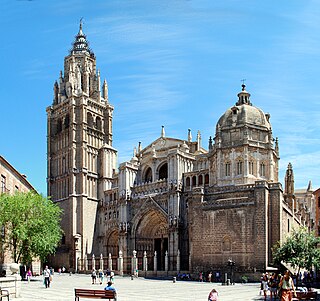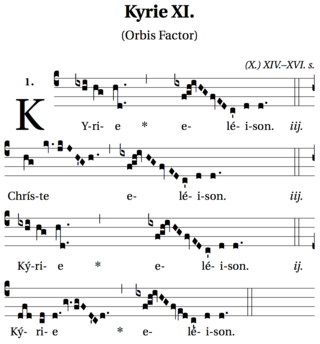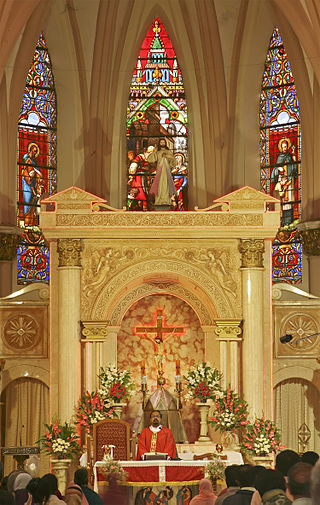
The Mass of Paul VI, also known as the Ordinary Form or Novus Ordo, is the most commonly used liturgy in the Catholic Church. It was promulgated by Pope Paul VI in 1969 and its liturgical books were published in 1970; those books were then revised in 1975, they were revised again by Pope John Paul II in 2000, and a third revision was published in 2002.

The Mozarabic Rite, officially called the Hispanic Rite, and in the past also called the Visigothic Rite, is a liturgical rite of the Latin Church once used generally in the Iberian Peninsula (Hispania), in what is now Spain and Portugal. While the liturgy is often called 'Mozarabic' after the Christian communities that lived under Muslim rulers in Al-Andalus that preserved its use, the rite itself developed before and during the Visigothic period. After experiencing a period of decline during the Reconquista, when it was superseded by the Roman Rite in the Christian states of Iberia as part of a wider programme of liturgical standardization within the Catholic Church, efforts were taken in the 16th century to revive the rite and ensure its continued presence in the city of Toledo, where it is still celebrated today. It is also celebrated on a more widespread basis throughout Spain and, by special dispensation, in other countries, though only on special occasions.

Kyrie, a transliteration of Greek Κύριε, vocative case of Κύριος (Kyrios), is a common name of an important prayer of Christian liturgy, also called the Kyrie eleison.
Christian liturgy is a pattern for worship used by a Christian congregation or denomination on a regular basis. The term liturgy comes from Greek and means "public work". Within Christianity, liturgies descending from the same region, denomination, or culture are described as ritual families.

In Christianity, worship is the act of attributing reverent honour and homage to God. In the New Testament, various words are used to refer to the term worship. One is proskuneo which means to bow down to God or kings.

The Dicastery for Divine Worship and the Discipline of the Sacraments is the dicastery of the Roman Curia that handles most affairs relating to liturgical practices of the Latin Church as distinct from the Eastern Catholic Churches and also some technical matters relating to the sacraments.

The Latin Mass Society of England and Wales is a Catholic society dedicated to making the Extraordinary Form of the Roman Rite, also known as the Tridentine Mass, more widely available in England and Wales. The group organised a petition for the Latin Mass in England and Wales which the Archbishop of Westminster, John Cardinal Heenan, presented to Pope Paul VI, who granted a papal indult in 1971.

The Roman Rite is the most common ritual family for performing the ecclesiastical services of the Latin Church, the largest of the sui iuris particular churches that comprise the Catholic Church. The Roman Rite governs rites such as the Roman Mass and the Liturgy of the Hours as well as the manner in which sacraments and blessings are performed.

Latin liturgical rites, or Western liturgical rites, is a large family of liturgical rites and uses of public worship employed by the Latin Church, the largest particular church sui iuris of the Catholic Church, that originated in Europe where the Latin language once dominated. Its language is now known as Ecclesiastical Latin. The most used rite is the Roman Rite.
The Paschal mystery is one of the central concepts of Catholic faith relating to the history of salvation. According to the Compendium of the Catechism of the Catholic Church, "The Paschal Mystery of Jesus, which comprises his passion, death, resurrection, and glorification, stands at the center of the Christian faith because God's saving plan was accomplished once for all by the redemptive death of himself as Jesus Christ." The Catechism states that in the liturgy of the Church "it is principally his own Paschal mystery that Christ signifies and makes present."

Piero Marini is a Roman Catholic archbishop who is president emeritus of the Pontifical Committee for International Eucharistic Congresses. For twenty years he served as Master of Pontifical Liturgical Celebrations, in charge of the Office for the Liturgical Celebrations of the Supreme Pontiff. In that capacity he worked for Popes John Paul II for 18 years and Benedict XVI for two years.

Annibale Bugnini was a Catholic prelate. Ordained in 1936 and named archbishop in 1972, he was secretary of the commission that worked on the reform of the Roman Rite that followed the Second Vatican Council. Both critics and proponents of the changes made to the Mass, the Liturgy of the hours and other liturgical practices before and after Vatican II consider him a dominant force in these efforts. He held several other posts in the Roman Curia and ended his career as papal nuncio to Iran, where he acted as an intermediary during the Iran hostage crisis of 1979 to 1981.
Louis Bouyer, CO, was a French Catholic priest and former Lutheran minister who was received into the Catholic Church in 1939. During his religious career he was an influential theological thinker, especially in the fields of history, liturgy and spirituality, and as peritus helped shape the vision of the Second Vatican Council. Along with Joseph Cardinal Ratzinger, Hans Urs von Balthasar, and others, he was a co-founder of the international review Communio. He was chosen by the pope to be part of a team to initiate the International Theological Commission in 1969.

Versus populum is the liturgical stance of a priest who, while celebrating Mass, faces the people from the other side of the altar. The opposite stance, that of a priest facing in the same direction as the people, is today called ad orientem or ad apsidem.
Francis Anthony Baring Pollen, FRIBA was an English architect who designed, amongst other significant buildings, Worth Abbey in West Sussex.
Gerard Thomas Goalen was a British architect who specialised in church architecture and was influenced by continental models and the Liturgical Movement. He was one of the most important architects of the Catholic Modernist movement in the United Kingdom during the 20th century.
Desmond Williams is a 20th century British architect who specialised in church architecture and was influenced by the Liturgical Movement. He was one of the most important architects of the Catholic Modernist movement in the United Kingdom.
Austin S. Winkley is a British architect who specialises in church architecture and is a member of the Liturgical Movement of UK ecclesiastical architects.
Peter Hammond (1921–1999) was a priest, writer, teacher and artist best known for his writings on church architecture and his significant influence on the modernising of church architecture as part of the Liturgical Movement.
Robert Maguire (1931-2019) was an influential British modernist architect and leading thinker in the British liturgical architectural movement of the Church of England. Maguire’s St Paul’s Church at Bow Common was voted the best church of the twentieth century in the UK.










